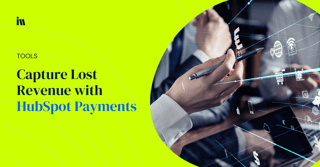
For many organizations, taking payments is part of everyday business processes. Whether you have a subscription, collect donations, sell a product, or more, being able to accept payments is critical to keeping your business running. Combine that with the ever-increasing adoption of the web and the importance of having a customer-engaging website, some businesses might find themselves missing out on achieving an amazing customer experience on their website.
Enter HubSpot payments. With HubSpot payments, you’re able to easily accept payments through your website and directly increase captured revenue through an automated, self-serve model.
What’s Inside:
- What Are HubSpot Payments?
- Payment Fundamentals
- Which E-Commerce Option Is Right for You?
What Are HubSpot Payments?
HubSpot payments are native tools built into your HubSpot Sales Hub, work seamlessly with your HubSpot CRM and integrate with all other aspects of the HubSpot platform.
Payments, quoting, and invoicing were a cobbled system previously. Oftentimes CRMs like HubSpot, Salesforce, and others were totally separate from commerce platforms like PayPal, Stripe, and QuickBooks. HubSpot has taken steps toward combining them into one platform for streamlined business operations and increased revenue generation through your website.
Now you have access to tools such as payment links, recurring payments for subscription services, and native quoting tools that integrate with payment processors and accounting software right at your fingertips.
This opens the door for a variety of opportunities:
- Touchless Selling: Easily include “buy now” links and checkout directly on your website so users can submit a payment without ever needing to talk to a sales rep. Embed these directly on your website through the CMS to spin up conversion pages and implement additional service models in minutes.
- Rep-Assisted Selling: Empower your sales reps to generate quotes for new business. By integrating through their Quotes API and making use of pre-built quoting templates, reps can provide easy checkout directly from a sent quote without a ton of manual data entry.
- Commerce Objects: With a slew of new objects around commerce, you can enhance your contact records through various associations around automation and reporting, subscription fields, and payment options. This gives you valuable information for future marketing and re-engagement efforts with existing customers.
Payment Fundamentals
With any e-commerce functionality, you will have several parts:
- Point of Purchase: This is where a customer actually makes the purchase, which is typically your website. It can be on a dedicated landing page, a product listing page, or in a full online store like you would see when visiting Macy’s or Amazon.
- Payment Processor: This is what actually processes the payment and captures the money from the credit card or bank account. Examples of payment processors are Stripe, Pay Pal, Authorize.net, as well as bank provided options. Something to be aware of is the security necessary for online payments. You may have a bank-issued processor or point of sale (POS) system. However, that may not be sufficient for taking payments online.
- Payment Gateway: If your payment processor doesn’t connect directly to your point of purchase, then you’ll need to use a gateway to connect the two. Careful - oftentimes using a payment gateway results in additional fees, so it is often advisable to use a processor that works directly with your point of purchase.
Things to Consider When Processing Payments
For every transaction you will have to pay fees. This is global no matter which service you use. For each transaction, you will have a transaction fee and a processing fee. Typically your transaction fees are around $0.25 giver or take depending on the provider. Additionally, you’ll pay a processing fee which is a percentage of the transaction. HubSpot provides competitive processing fees at 2.9%. Check out their FAQ for more information.
Additionally, there are three focuses of payment fundamentals. The buyer’s experience, the merchant’s experience, and how to handle recurring payments or subscriptions.
Buyer Payment Experience
When it comes to the buyer, the general rule of thumb is to make it as seamless as possible. Amazon has captured this secret sauce and it’s part of the reason they’ve become so successful. To support the buyer's experience, HubSpot payments provides easy checkout pages with pre-built templates. Also, transactional receipts are sent to customers after purchase, and the ability to build engagement by offering discounts through the platform all help foster the customer relationship.
Merchant Payment Experience
From the merchant side, we have different considerations. Refunds, for example, are an important functionality for merchants to have. Additionally, sales and conversion notifications help with visibility for accounting and the ability to send payouts. Having all of this baked into a single platform with an automated approach empowers organizations with the tools to conduct business seamlessly.
Recurring Payments
Lastly, recurring payments or subscriptions tend to be a hurdle many other payment options run into. Being able to automatically trigger a payment every month is a feat of its own. Being able to integrate that with accounting software is a whole other game-changer that HubSpot payments is leading the charge on. Being able to manage the subscriptions of various audiences through an automated system, with the necessary notifications of failures, processing, and more is a very powerful tool indeed.
Which E-Commerce Option Is Right for You?
When deciding what option is right for you, it is best to consider what the main focus of your website is. Are you a retailer whose main focus is selling products? Do you have 20+ products with different sizes, variations, etc.? If so, then you will want to consider an online store. Platforms like Shopify and Big Commerce provide a lot of the store functionality you’ll need right out of the box from shipping configuration to sales tax. Since the main focus is to display and sell products, this would be your best option. Note: you will still need a payment processor to capture payment on your online store.
Now if your website’s primary focus is informational, if your organization is B2B, or you have a smaller number of products and services to offer, then you’ll want to consider a payment provider that easily bolts onto your website such as HubSpot payments. Since processing payments is a “feature” and not the primary goal of the site, ensuring your provided solution is easily incorporated into your content management system, as well as integrated with your CRM and sales/marketing platforms, are all considerations you’ll want to take into account. That’s what makes HubSpot payments so revolutionary. By integrating with your CRM, deal records, and reporting, you can spend more time analyzing your data instead of entering it. With additional features like integrating with QuickBooks Online and leveraging workflows to trigger invoices and payments, you can affect business processes on an organizational level.
It’s clear that the ability to accept payments through your website is beneficial to any organization. Where it was once a cobbled framework that was complicated to implement through a Frankenstein approach and using multiple services, now you can easily enhance your site quickly to begin testing various use cases and capturing more revenue for your organization.
To see HubSpot payments in action, and purchase a 10hr consulting block to see how we can help your organization implement a payment solution.

